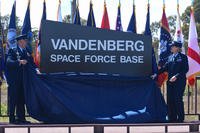PEARL HARBOR, Hawaii -- A survivor from the Dec. 7, 1941, Japanese attack on Pearl Harbor visited the Center for Security Forces Detachment Pearl Harbor Oct. 18 to tour the site and exact location of where he was during the attack - Hangar 54.
Dick Girocco, a U.S. Navy seaman at age 20, was inside Hangar 54 when the Japanese air strike against U.S. forces began on that infamous day of nearly 71 years ago.
"My immediate reaction was to run out front of this hangar because we suspected the Army Air Corps were playing tricks on us. They use to do that on occasion and dive bomb us with flour sacks. When the 'flour sacks' began exploding, things got a little hairy," said Girocco, recalling the initial moments of the attack.
The Japanese attack began at 7:55 a.m. with two air-attack forces that totaled more than 350 aircraft and a battle group consisting of 30 surface ships and 35 submarines.
"By that time, we could see the rising sun on the wings [and] from that minute on it was a matter of self-preservation. Our first impulse was to run 180-degrees away from them and so we went out the back of this hangar. It was all dirt between this hanger and the next, [but] we found little depressions to lie in and wait out the attack," said Girocco.
Girocco went on to explain that luckily the Navy had been laying a pipeline between the two hangars and that he along with others, found refuge there for the remainder of the attack.
The attack on Pearl Harbor left 20 U.S. ships either sunk or damaged in varying degrees. The Navy and Army Air Corps lost a combined 169 planes with another 159 damaged. U.S. casualties reached 2,403 dead and another 1,178 wounded.
When asked what he thought about the new developments alongside the old buildings on Ford Island, Girocco said, "I think what is happening is nice. It does not bring back a lot of memories because there is a good period of my memory that is blocked out. The first couple of days I remember very well, but then the next couple of weeks after that, maybe a month or so, are a total blank."
Among the 20 U.S. ships sunk or damaged in the attack, all returned to service by 1944 except for USS Arizona (BB 39), USS Oklahoma (BB-37), and USS Utah (BB 31). The Japanese formerly surrendered to the U.S. Sept. 2, 1945 aboard USS Missouri (BB 63) in Tokyo Bay. The battleship USS West Virginia (BB 31/AG 16), sunk during the attack at Pearl Harbor, was also present in Tokyo Bay and served as a testament to the ingenuity and resolve of the American people.
This type of ingenuity and resolve continues into present day as Hangar 54 now serves as a training site for Navy Security Forces personnel.
The Center for Security Forces provides specialized training to more than 22,000 students each year and has 14 training locations throughout the U.S. and around the world.
























